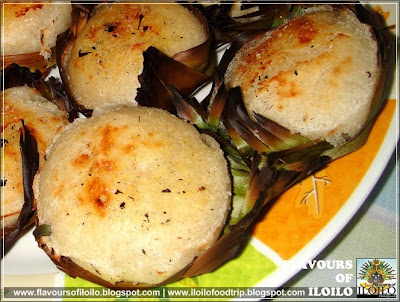Bingka is very much synonymous with Holy Week here in the heritage town of Sta. Barbara, Iloilo.Unlike in the plazas of Iloilo City, where bingka stalls are a staple year round, it is only during Lenten season that these bingkas in our town make their presence felt - bigtime. Eversince I was a kid, rows and rows of bingka stalls dot the town plaza during this time of the year. Townsfolk would feast on these native delicacies after participating in the Holy Week rites creating a fiesta like atmosphere in the plaza. This bingka tradition in our town remained almost the same with the exception of new players coming in while the old ones fade out. So today, Holy Monday, I started my local bingka feast as I bought from two different stalls. The first thing I've noticed is that bingkas sold here in our town are very much different from the ones I've tried in the city. While the latter are thin, chewy and moist, bingkas here were much thicker, spongy (and air-filled) and sort of dry inside out. Yet both seem to have a distinct taste of their own that I both love.
So today, Holy Monday, I started my local bingka feast as I bought from two different stalls. The first thing I've noticed is that bingkas sold here in our town are very much different from the ones I've tried in the city. While the latter are thin, chewy and moist, bingkas here were much thicker, spongy (and air-filled) and sort of dry inside out. Yet both seem to have a distinct taste of their own that I both love.  So to start my bingka quest, here' a rather good looking one, inside out yet it had soemwhat a sour aftertaste especially at mid part. It was fresh from the oven when I bought it so it doesn't mean it's old. It also has a generous buko strips filling compared with other bingkas.
So to start my bingka quest, here' a rather good looking one, inside out yet it had soemwhat a sour aftertaste especially at mid part. It was fresh from the oven when I bought it so it doesn't mean it's old. It also has a generous buko strips filling compared with other bingkas.

 So today, Holy Monday, I started my local bingka feast as I bought from two different stalls. The first thing I've noticed is that bingkas sold here in our town are very much different from the ones I've tried in the city. While the latter are thin, chewy and moist, bingkas here were much thicker, spongy (and air-filled) and sort of dry inside out. Yet both seem to have a distinct taste of their own that I both love.
So today, Holy Monday, I started my local bingka feast as I bought from two different stalls. The first thing I've noticed is that bingkas sold here in our town are very much different from the ones I've tried in the city. While the latter are thin, chewy and moist, bingkas here were much thicker, spongy (and air-filled) and sort of dry inside out. Yet both seem to have a distinct taste of their own that I both love.  So to start my bingka quest, here' a rather good looking one, inside out yet it had soemwhat a sour aftertaste especially at mid part. It was fresh from the oven when I bought it so it doesn't mean it's old. It also has a generous buko strips filling compared with other bingkas.
So to start my bingka quest, here' a rather good looking one, inside out yet it had soemwhat a sour aftertaste especially at mid part. It was fresh from the oven when I bought it so it doesn't mean it's old. It also has a generous buko strips filling compared with other bingkas.

This one may not be as big nor is filled with generous coconut strips but it tastes much better then the previous one. It also seems not fully cooked but it was also hot off the oven when I bought it. 

I'll be making round more of the bingkas stalls this Holy Week and this is actually the start of it, so expect more in the days to come.
